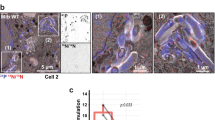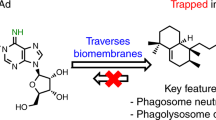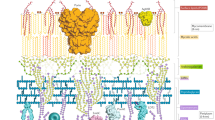Abstract
The detection of tuberculosis currently relies upon insensitive and unspecific techniques; newer diagnostics would ideally co-opt specific bacterial processes to provide real-time readouts. The trehalose mycolyltransesterase enzymes (antigens 85A, 85B and 85C (Ag85A, Ag85B, Ag85C)) serve as essential mediators of cell envelope function and biogenesis in Mycobacterium tuberculosis. Through the construction of a systematically varied sugar library, we show here that Ag85 enzymes have exceptionally broad substrate specificity. This allowed exogenously added synthetic probes to be specifically incorporated into M. tuberculosis growing in vitro and within macrophages. Even bulky substituents, such as a fluorescein-containing trehalose probe (FITC-trehalose), were incorporated by growing bacilli, thereby producing fluorescent bacteria; microscopy revealed selective labeling of poles and membrane. Addition of FITC-trehalose to M. tuberculosis–infected macrophages allowed selective, sensitive detection of M. tuberculosis within infected mammalian macrophages. These studies suggest that analogs of trehalose may prove useful as probes of function and for other imaging modalities.
This is a preview of subscription content, access via your institution
Access options
Subscribe to this journal
Receive 12 print issues and online access
$259.00 per year
only $21.58 per issue
Buy this article
- Purchase on Springer Link
- Instant access to full article PDF
Prices may be subject to local taxes which are calculated during checkout




Similar content being viewed by others
Accession codes
References
World Health Organization. Global Tuberculosis Control Report 2008 (2008).
Young, D.B. Confronting the scientific obstacles to global control of tuberculosis. J. Clin. Invest. 118, 1255–1265 (2008).
Daffé, M. & Etienne, G. The capsule of Mycobacterium tuberculosis and its implications for pathogenicity. Tuber. Lung Dis. 79, 153–169 (1999).
Murphy, H.N. et al. The OtsAB pathway is essential for trehalose biosynthesis in Mycobacterium tuberculosis. J. Biol. Chem. 280, 14524–14529 (2005).
Woodruff, P.J. et al. Trehalose is required for growth of Mycobacterium smegmatis. J. Biol. Chem. 279, 28835–28843 (2004).
Hoffmann, C., Leis, A., Niederweis, M., Plitzko, J.M. & Engelhard, H. Disclosure of the mycobacterial outer membrane: Cryo-electron tomography and vitreous sections reveal the lipid bilayer structure. Proc. Natl. Acad. Sci. USA 105, 3963–3967 (2008).
Yamagami, H. et al. Trehalose 6,6′-dimycolate (cord factor) of Mycobacterium tuberculosis induces foreign-body- and hypersensitivity-type granulomas in mice. Infect. Immun. 69, 810–815 (2001).
Barry, C.E. & Mdluli, K. Drug sensitivity and environmental adaptation of mycobacterial cell wall components. Trends Microbiol. 4, 275–281 (1996).
Kilburn, J.O., Takayama, K.K. & Armstrong, E.E.L. Synthesis of trehalose dimycolate (cord factor) by a cell-free system of Mycobacterium smegmatis. Biochem. Biophys. Res. Commun. 108, 132–139 (1982).
Fukui, Y., Hirai, T., Uchida, T. & Yoneda, M. Extracellular proteins of tubercle bacilli. IV. Alpha and beta antigens as major extracellular protein products and as cellular components of a strain (H37Rv) of Mycobacterium tuberculosis. Biken J. 8, 189–199 (1965).
Jackson, M. et al. Inactivation of the antigen 85C gene profoundly affects the mycolate content and alters the permeability of the Mycobacterium tuberculosis cell envelope. Mol. Microbiol. 31, 1573–1587 (1999).
Puech, V., Bayan, N., Salim, K., Leblon, G. & Daffe, M. Characterization of the in vivo acceptors of the mycoloyl residues transferred by the corynebacterial PS1 and the related mycobacterial antigens 85. Mol. Microbiol. 35, 1026–1041 (2000).
Ronning, D.R. et al. Crystal structure of the secreted form of antigen 85C reveals potential targets for mycobacterial drugs and vaccines. Nat. Struct. Biol. 7, 141–146 (2000).
Anderson, D.H., Harth, G., Horwitz, M.A. & Eisenberg, D. An interfacial mechanism and a class of inhibitors inferred from two crystal structures of the Mycobacterium tuberculosis 30 kDa major secretory protein (Antigen 85B), a mycolyl transferase. J. Mol. Biol. 307, 671–681 (2001).
Ronning, D.R., Vissa, V., Besra, G.S., Belisle, J.T. & Sacchettini, J.C. Mycobacterium tuberculosis antigen 85A and 85C structures confirm binding orientation and conserved substrate specificity. J. Biol. Chem. 279, 36771–36777 (2004).
Belisle, J.T. et al. Role of the major antigen of Mycobacterium tuberculosis in cell wall biogenesis. Science 276, 1420–1422 (1997).
Titgemeyer, F. et al. A genomic view of sugar transport in Mycobacterium smegmatis and Mycobacterium tuberculosis. J. Bacteriol. 189, 5903–5915 (2007).
Kalscheuer, R., Weinricka, B., Veeraraghavan, U., Besra, G.S. & Jacobs, W.R. Trehalose-recycling ABC transporter LpqY-SugA-SugB-SugC is essential for virulence of Mycobacterium tuberculosis. Proc. Natl. Acad. Sci. USA (2010).
Slayden, R.A. & Barry, C.E. The genetics and biochemistry of isoniazid resistance in Mycobacterium tuberculosis. Microbes Infect. 2, 659–669 (2000).
Tufariello, J.M., Chan, J. & Flynn, J.L. Latent tuberculosis: mechanisms of host and bacillus that contribute to persistent infection. Lancet Infect. Dis. 3, 578–590 (2003).
Demchenko, A.V. 1,2-cis O-Glycosylation: methods, strategies, principles. Curr. Org. Chem. 7, 35–79 (2003).
Pratt, M.R., Leigh, C.D. & Bertozzi, C.R. Formation of 1,1-alpha,alpha-glycosidic bonds by intramolecular aglycone delivery. A convergent synthesis of trehalose. Org. Lett. 5, 3185–3188 (2003).
Gobec, S. et al. Design, synthesis, biochemical evaluation and antimycobacterial action of phosphonate inhibitors of antigen 85C, a crucial enzyme involved in biosynthesis of the mycobacterial cell wall. Eur. J. Med. 42, 54–63 (2007).
Hui, Y. & Chang, C.W. Convenient divergent synthesis of a library of trehalosamine analogues. Org. Lett. 4, 2245–2248 (2002).
Hadfield, A.F., Hough, L. & Richardson, A.C. The syntheses of 4,6-dideoxy-4,6-difluoro- and 4-deoxy-4-fluoro-alpha,alpha-trehalose. Carbohydr. Res. 71, 95–102 (1979).
Namme, R., Hideyo, T.M. & Ikegami, T.S. Development of ketoside-type analogues of trehalose by using stereoselective O-glycosidation of ketose. Eur. J. Org. Chem. 2007, 3758–3764 (2007).
Li, X., Ohtake, H., Takahashi, H. & Ikegami, S. A facile synthesis of 1′-C-alkyl-α-disaccharides from 1-C-alkyl-hexopyranoses and methyl 1-C-methyl-hexopyranosides. Tetrahedron 57, 4297–4309 (2001).
Rodríguez, M.A. et al. Synthesis of 2-iodoglycals, glycals, and 1,1′-disaccharides from 2-deoxy-2-iodopyranoses under dehydrative glycosylation conditions. J. Org. Chem. 72, 8998–9001 (2007).
Giaever, H.M., Styrvold, O.B., Kaasen, I. & Strom, A.R. Biochemical and genetic characterization of osmoregulatory trehalose synthesis in Escherichia coli. J. Bacteriol. 170, 2841–2849 (1988).
Yang, M. et al. Probing the breadth of macrolide glycosyltransferases: in vitro remodeling of a polyketide antibiotic creates active bacterial uptake and enhances potency. J. Am. Chem. Soc. 127, 9336–9337 (2005).
Converse, S.E. et al. MmpL8 is required for sulfolipid-1 biosynthesis and Mycobacterium tuberculosis virulence. Proc. Natl. Acad. Sci. USA 100, 6121–6126 (2003).
Hatzios, S.K. et al. PapA3 is an acyltransferase required for polyacyltrehalose biosynthesis in Mycobacterium tuberculosis. J. Biol. Chem. 284, 12745–12751 (2009).
Abadie, V. et al. Neutrophils rapidly migrate via lymphatics after Mycobacterium bovis BCG intradermal vaccination and shuttle live bacilli to the draining lymph nodes. Blood 106, 1843–1850 (2005).
Spargo, B.J., Crowe, L.M., Ioneda, T., Beaman, B.L. & Crowe, J.H. Cord factor (alpha,alpha-trehalose 6,6′-dimycolate) inhibits fusion between phospholipid vesicles. Proc. Natl. Acad. Sci. USA 88, 737–740 (1991).
Indrigo, J., Hunter, R.L. Jr. & Actor, J.K. Cord factor trehalose 6,6′-dimycolate (TDM) mediates trafficking events during mycobacterial infection of murine macrophages. Microbiology 149, 2049–2059 (2003).
Fratti, R.A., Backer, J.M., Gruenberg, J., Corvera, S. & Deretic, V. Role of phosphatidylinositol 3-kinase and Rab5 effectors in phagosomal biogenesis and mycobacterial phagosome maturation arrest. J. Cell Biol. 154, 631–644 (2001).
Kyei, G.B. et al. Rab14 is critical for maintenance of Mycobacterium tuberculosis phagosome maturation arrest. EMBO J. 25, 5250–5259 (2006).
Ullrich, H.J., Beatty, W.L. & Russell, D.G. Direct delivery of procathepsin D to phagosomes: implications for phagosome biogenesis and parasitism by Mycobacterium. Eur. J. Cell Biol. 78, 739–748 (1999).
Sturgill-Koszycki, S. et al. Lack of acidification in Mycobacterium phagosomes produced by exclusion of the vesicular proton-ATPase. Science 263, 678–681 (1994).
Matsunaga, I. et al. Mycolyltransferase-mediated glycolipid exchange in mycobacteria. J. Biol. Chem. 283, 28835–28841 (2008).
Beatty, W.L. et al. Trafficking and release of mycobacterial lipids from infected macrophages. Traffic 1, 235–247 (2000).
Thanky, N.R., Young, D.B. & Robertson, B.D. Unusual features of the cell cycle in mycobacteria: polar-restricted growth and the snapping-model of cell division. Tuberculosis (Edinb.) 87, 231–236 (2007).
Provvedi, R., Boldrin, F., Falciani, F., Palu, G. & Manganelli, R. Global transcriptional response to vancomycin in Mycobacterium tuberculosis. Microbiology-Sgm 155, 1093–1102 (2009).
Glatman-Freedman, A., Martin, J.M., Riska, P.F., Bloom, B.R. & Casadevall, A. Monoclonal antibodies to surface antigens of Mycobacterium tuberculosis and their use in a modified enzyme-linked immunosorbent spot assay for detection of mycobacteria. J. Clin. Microbiol. 34, 2795–2802 (1996).
Cole, S.T. et al. Deciphering the biology of Mycobacterium tuberculosis from the complete genome sequence. Nature 393, 537–544 (1998).
Schorey, J.S., Carroll, M.C. & Brown, E.J. A macrophage invasion mechanism of pathogenic mycobacteria. Science 277, 1091–1093 (1997).
Weingart, C.L. et al. Fluorescent labels influence phagocytosis of Bordetella pertussis by human neutrophils. Infect. Immun. 67, 4264–4267 (1999).
Anderson, D.H. et al. An interfacial mechanism and a class of inhibitors inferred from two crystal structures of the Mycobacterium tuberculosis 30 kDa major secretory protein (Antigen 85B), a mycolyl transferase. J. Mol. Biol. 307, 671–681 (2001).
Acknowledgements
We thank T. Claridge, B. Odell and T. Jackson for assistance with NMR spectra and C. Sparrow, J. McCullagh and R. Procter for their assistance with mass spectrometry. O. Schwartz, L. Koo, M. Gastinger, S. Becker and J. Kabat provided tremendous assistance on all imaging of M. tuberculosis. We thank the Colorado State “Tuberculosis Vaccine Testing and Research Materials” Contract (Colorado State University, Fort Collins) and G.J. Davies (University of York) for providing Ag85 and OtsA plasmids, respectively. We thank A. Sher (US National Institute of Allergy and Infectious Disease, US National Institutes of Health) for M. bovis BCG expressing DSRed1 and T. Oh (Yonsei University) for H37Rv carrying the mCherry-PMV261 plasmid. This study was supported (in part) by the Intramural Research Program of the US National Institutes of Health, the US National Institute of Allergy and Infectious Disease (C.E.B.), the Rhodes Trust (K.M.B.), a Marie Curie Intra European Fellowship (O.B.), the Engineering and Physical Sciences Research Council (Platform Grant to B.G.D.) and the Bill and Melinda Gates Foundation through the Tuberculosis Drug Accelerator Program (C.E.B., B.G.D.).
Author information
Authors and Affiliations
Contributions
K.M.B., H.I.B., C.S.B., L.E.V., C.E.B. and B.G.D. designed experiments. K.M.B., O.B., M.K.P., F.D. and S.S.L. synthesized compounds. K.M.B., K.T. and H.I.B. performed uptake experiments. C.S.B. and K.M.B. performed substrate screens. K.M.B., H.I.B., C.S.B., C.E.B. and B.G.D. analyzed results. K.M.B., C.E.B. and B.G.D. wrote the paper.
Corresponding authors
Ethics declarations
Competing interests
The work from this paper has been filed as a patent application for the detection of mycobacteria by the University of Oxford and the US National Institutes of Health and, if licensed, will afford authors royalties in line with the set down guidelines of both institutions.
Supplementary information
Supplementary Text and Figures
Supplementary Methods, Supplementary Figures 1–34, Supplementary Schemes 1–16 and Supplementary Table (PDF 13676 kb)
Rights and permissions
About this article
Cite this article
Backus, K., Boshoff, H., Barry, C. et al. Uptake of unnatural trehalose analogs as a reporter for Mycobacterium tuberculosis. Nat Chem Biol 7, 228–235 (2011). https://doi.org/10.1038/nchembio.539
Received:
Accepted:
Published:
Issue Date:
DOI: https://doi.org/10.1038/nchembio.539
This article is cited by
-
In vivo imaging of MmpL transporters reveals distinct subcellular locations for export of mycolic acids and non-essential trehalose polyphleates in the mycobacterial outer membrane
Scientific Reports (2023)
-
PPE51 mediates uptake of trehalose across the mycomembrane of Mycobacterium tuberculosis
Scientific Reports (2022)
-
The role of transport proteins in the production of microbial glycolipid biosurfactants
Applied Microbiology and Biotechnology (2021)
-
The MmpL3 interactome reveals a complex crosstalk between cell envelope biosynthesis and cell elongation and division in mycobacteria
Scientific Reports (2019)
-
Sequential assembly of the septal cell envelope prior to V snapping in Corynebacterium glutamicum
Nature Chemical Biology (2019)



